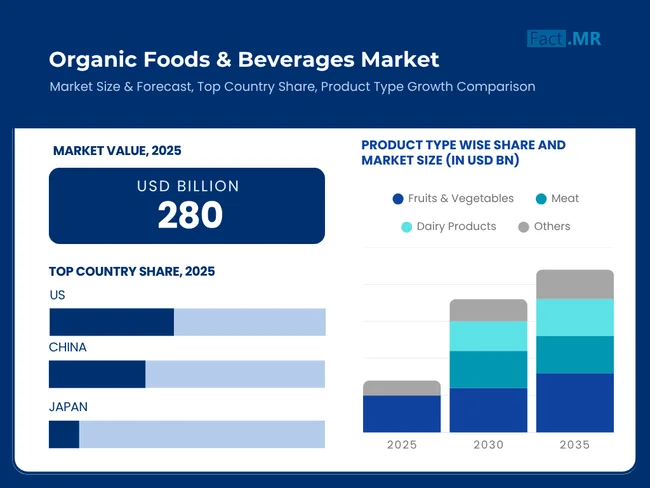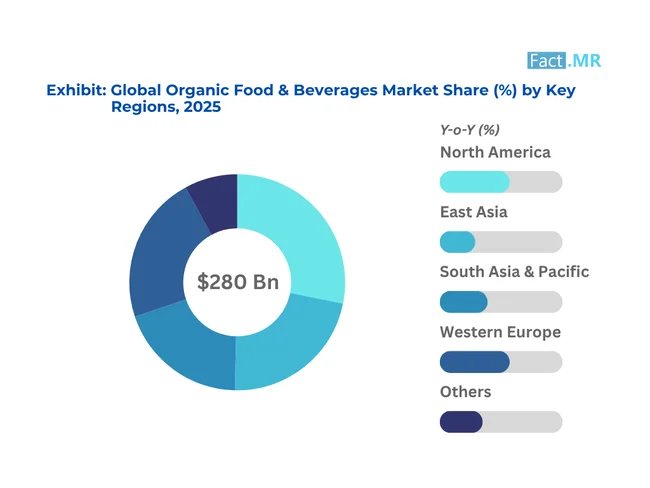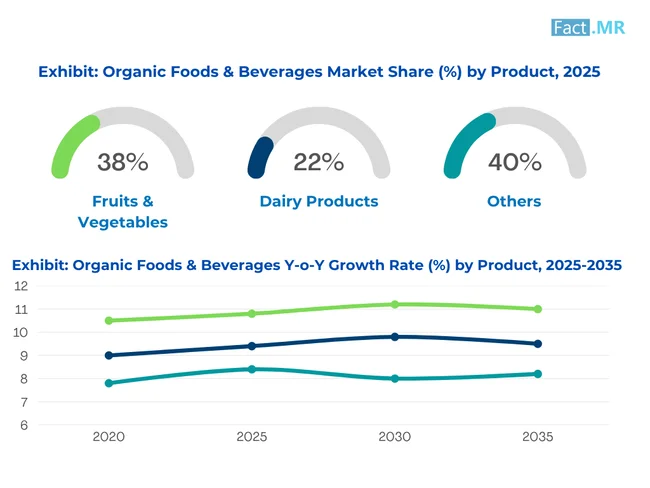Organic Foods & Beverages Market
Organic Foods & Beverages Market Analysis, By Product (Fruits & Vegetables, Meat, and Others), By Distribution, By Packaging Type, and Region - Market Insights 2025 to 2035
The fruit & vegetable segment projected to grow at a CAGR of 9.6%, whereas the meat segment is likely to grow at 11.3%. In terms of countries, India projected to grow at 15.1%, followed by China at 14.6% and U.S. to grow at 12.8%
Organic Foods & Beverages Market Outlook (2025 to 2035)
The global organic foods and beverages market is expected to reach USD 669 billion by 2035, up from USD 248.1 billion in 2024. During the forecast period (2025 – 2035), the industry is projected to expand at a CAGR of 9.1%.
The organic foods and beverages market has emerged as a vital force in reshaping consumer preferences toward health-conscious, sustainable living. Rising concerns over food safety, environmental impact, and dietary transparency are fueling its rapid adoption. As clean-label trends intensify and plant-based innovations flourish, the market is becoming central to the future of food, offering both nutritional value and ethical consumption choices.

What are the drivers of the Organic Foods & Beverages market?
The organic foods & beverages market is gaining rapid traction due to increasing consumer awareness around health, nutrition, and environmental sustainability. One of the primary drivers is the growing demand for food products free from synthetic pesticides, genetically modified organisms, and artificial preservatives. As people become more aware of the long-term health implications of chemical-based foods, demand for organic foods receives an added boost.
Shifts in sustainable consumption further accelerate the industry. Currently, customers are seeking products that align with their ethical and environmental values. Thus, fair trade sourcing, regenerative agriculture, and eco-friendly packaging have a significant influence on millennials and Gen Z alike, who drive modern consumption patterns in society.
Accessibility is improving in retail, and organic produce is now available everywhere, with mainstream supermarkets, specialty stores, and online sources. Governments have also supported the organic movement through subsidies for organic farming, awareness creation initiatives, and more rigorous labeling to enhance consumers' confidence.
The expansion of functional foods, plant-based foods, and clean-label drinks further reinforces the growth of the organic sector. Organic brands are developing innovative solutions to address these evolving needs, as consumers increasingly seek products that support immunity, gut health, and energy. All these drivers are driving strong market momentum together.
What are the regional trends of the Organic Foods & Beverages market?

North America leads the organic foods & beverages market, driven by a mature health-conscious population and a well-established regulatory infrastructure. The United States, in particular, exhibits strong demand due to the readily available certified organic foodstuffs, the high spending power of consumers, and robust organic farming networks. Online grocery and direct-to-consumer channels only accelerated product reach and convenience.
Europe follows closely, with its commitment to sustainability and stringent food safety regulations significantly influencing consumer behavior. Countries like Germany, France, and the Netherlands have deeply embedded organic cultures, supported by government programs that incentivize organic farming and transparent labeling. The demand here is not only for health benefits but also for reducing environmental impact.
Asia-Pacific is witnessing rapid growth in the industry. Rising disposable income and heightened concerns regarding food safety and urbanization are driving this growth. China and India are witnessing an expanding middle class that is willing to pay more for trusted, clean food. Japan and South Korea focus on premium organic beverages and value-added health products, supported by domestic production and tech-enabled agriculture.
Latin America and the Middle East & Africa are in earlier growth stages but are showing promise. In Brazil and Mexico, the rise of health-conscious middle-class consumers is driving demand for organic products. In the Gulf countries, the growth of organic imports and high-end retail is introducing these products to affluent buyers. While still niche in many areas, awareness and accessibility are steadily improving.
What are the challenges and restraining factors of the Organic Foods & Beverages market?
Despite strong demand, the organic foods & beverages market faces several challenges that restrict widespread adoption. High production costs are a major drawback. Organic production tends to yield fewer crops than conventional agriculture and also requires more effort. Maintaining product prices is more expensive, making organic goods less accessible to a broader consumer base, especially in price-sensitive regions.
Supply chain limitations compound market scalability issues. Organic integrity in the supply chain is ensured with rigid segregation, certified processing, and rigorous documentation. Any deviation will compromise certification and brand confidence. All this raises the cost and complexity of logistics and inventory management.
There is also the issue of consumer confusion, as many buyers struggle to distinguish between truly organic products and those with misleading or unclear labels. In regions with weak regulatory enforcement, this skepticism limits trust and slows growth.
Additionally, seasonal availability and a lack of variety also play a role. Organic products depend on the particular climatic conditions, which are often not available year-round, resulting in a limited choice and consistency. Moreover, smaller organic farms may not be able to meet the volume requirements of large chain stores or food service establishments.
Even with these limitations, continued technological advancements in organic farming, enhanced regulatory systems, and growing health consciousness are expected to alleviate these difficulties and enable long-term expansion on a sustained basis.
Country-Wise Insights
Clean Label Preferences and Omnichannel Retail Drive U.S. Organic Boom
-2025-to-2035.webp)
Organic foods and beverages are experiencing high growth in the U.S. market, driven by increasing consumer interest in health, nutrition, and sustainability. Consumers are prioritizing organic options in everyday categories such as fruits and vegetables, snacks and beverages; clean-label ingredients and transparent sourcing are now baseline expectations.
Organic choices are no longer limited to premium segments. Increased retail penetration and consumer education are making the products more accessible to the broad spectrum of consumers. Governments, through their certification standards, provide a guarantee and clarity on what labeling means.
Environmental issues increasingly drive consumer behavior in purchasing decisions. Consumers now look for organically produced products, which provide assurance of sustainability, reduced packaging, and local origin. These preferences are shaping product development and distribution strategies.
Eco-Conscious Values and Artisan Quality Strengthen Germany’s Organic Leadership
Germany represents one of the most mature organic markets globally, characterized by extremely high consumer awareness and effective regulatory alignment. Organic food and beverages are viewed globally as the responsible and preferred choice, particularly in sectors such as dairy alternatives, grains, and packaged foods.
Cultural values that prioritize ecological stewardship and craftsmanship underpin further growth in organic consumption. Local origin and regional identity are significant drivers of purchase, with consumers often preferring products that are specific to their origin.
The policy framework is favorable to organic farming, encouraging soil fertility, biodiversity, and ecologically balanced agriculture. Consumers are increasingly focused on avoiding additives, understanding supply chains, and reducing their environmental footprint through daily food choices.
Food Safety Concerns and Urban Wellness Trends Accelerate China’s Organic Surge
China's organic market is growing rapidly, driven by concerns over food safety, increasing health awareness, and improved urban lifestyles in major cities. Young professionals and families are leading the shift towards organics, particularly in the grain, dairy, and functional beverages segments.
Although brand trust and certification awareness are increasing, consumer behavior is leaning toward transparency and authenticity. E-access to information about the production place and quality control has enhanced industry confidence.
Policy measures are promoting organic farming through pilots and incentives that foster sustainability. Urban demand is especially strong, with growing interest in chemical-free agriculture, eco-labels, and nutrient-rich organic foods that align with wellness goals.
Category-Wise Analysis
Pesticide-Free Produce Leads the Organic Revolution

Organic fruits and vegetables are leading the product category, backed by rising health awareness and the need for pesticide-free foods. Consumers are seeking clean-label foods that can help deliver wellness and sustainability goals. A steep rise in supermarket and specialty store sales of organic produce has been triggered by urbanization and rising disposable incomes.
The governments of India, Germany, and the United States are actively encouraging organic farming through funding, certification programs, and promotional campaigns. All this has led to increased farmer participation and enhanced supply chain management. In addition, effective modern traceability techniques and digital farming technologies are helping to ensure quality and freshness, as well as improve consumer trust. With a growing emphasis on disease prevention through diet and a continued transition toward plant-centric living, organic produce is expected to remain the most popular product segment in the next few years.
Digital Grocery Drives Access and Adoption
Digital distribution is gaining traction in the organic food and beverage market owing to the convenience, accessibility, and changing consumer behavior. Online grocery sites, subscription services, and direct-to-consumer transactions have made organic products available at the fingertips of tech-adopting urban consumers. Companies are utilizing mobile apps, tailored recommendations, and online checkout websites to enhance the customer experience.
Trust in this channel has been built largely through reliable cold chain logistics, expedited delivery options, and customer feedback. The online platform also offers opportunities for niche brands and local organic producers to gain visibility beyond traditional retail. The US, China, and India are driving momentum in these markets as consumers value safety, transparency, and the convenience of purchase. The future of organic retailing will be largely based on e-commerce innovations and online convenience.
Flexible, Eco-Friendly Packaging Redefines Convenience
Pouches and sachets are gradually gaining popularity among people as ready-to-go, flexible, and eco-friendly packaging alternatives in the organic industry. They were particularly preferred for baby food, snacks, sauces, and single-serve beverages. They offer advantages such as resealable facility, portability, and reduced packaging waste. With consumer demand shifting toward environmentally responsible solutions, brands are introducing compostable and recyclable pouches that align with green packaging goals. Among these developments, the multi-layered barrier film maintains the freshness and nutritional content of organic products while also extending their shelf life.
Light pouch weights lower transportation emissions and costs, making environmentally friendly companies and consumers a more appealing option. North American and European markets are at the forefront of green pouch packaging, driven by stringent environmental legislation and growing consumer awareness. As businesses increasingly strive to minimize their plastic footprint, pouches and sachets will play a critical role in driving innovation in the organic packaging sector.
Competitive Analysis
Key players in the organic foods & beverages industry include Albertsons Companies, Inc., Belvoir Fruit Farms Ltd., Clif Bar & Company, Danone S.A., General Mills Inc., Hain Celestial Group, Inc., Newman’s Own, Organic Valley, The J.M. Smucker Co., and Whole Foods Market IP. L.P.
These consumers are driving growth in the sector through the extension of mounting health awareness, demand for clean-label options, and expansion of organic-certified supply chains. Eco-friendly packaging innovations, plant-based alternatives, and collaborative partnerships with farmers and distributors have become the focal points in their market positioning. Sourcing visibility, environmental sustainability, and functional wellness advantages are shaping the competitive edge in this rapidly evolving industry.
Recent Development
- In June 2025, Sam’s Club announced the elimination of all artificial ingredients from its Member’s Mark products. This sweeping reform encompasses 1,250 items, including snacks, dairy products, frozen foods, and household goods. The initiative underscores a broader shift toward transparency, clean labels, and customer trust in private-label retail offerings.
- In October 2024, Recoup launched its organic prebiotic sparkling beverages nationwide in Sprouts Farmers Markets. Infused with ginger and functional botanicals, the drinks support digestion and hydration. This innovation combines USDA-certified organic ingredients with gut health benefits, reflecting growing consumer demand for clean-label, functional beverages in mainstream natural retail.
Fact.MR has provided detailed information about the price points of key manufacturers in the organic foods and beverages market, positioned across regions, including sales growth, production capacity, and speculative technological expansion, in the recently published report.
Methodology and Industry Tracking Approach
The 2025 version of the global organic foods & beverages market report by Fact.MR has analyzed responses from 12,500 industry stakeholders across 35 countries. The study covered at least 350 respondents per market, among whom two-thirds were end users or producers of organic foods and beverages, such as, but not limited to, organic dairy manufacturers, plant-based beverage producers, and natural grocery retail chains. One-third represented industry professionals, including supply chain managers, food safety and organic certification inspectors, and distributors involved in the sourcing, packaging, and international trade of organic consumables.
Researchers at Fact.MR captured market pulse, demand patterns, opportunity clusters, investment pockets, unmet needs, influencing factors, and industry risks over the period from May '24 to April ’25 by correlating collected responses from all possible nodes in the entire value chain.
Weighted ratio of respondent samples considered to reflect regional market shares and demographic distributions. Along with data from industry, the report also analyzes over 300 sources, spanning academic journals, patent filings, regulatory filings, Bill of Materials, 10K/10Q/SEC documents, and investor presentations, leveraging advanced statistical techniques such as regression analysis. Our approach ensures comprehensive coverage and precise insights.
Since 2018, Fact.MR has been capturing consumer behavior, product efficacy perceptions, industry trends, and dollar value opportunity across diverse applications, publishing research findings as the authoritative resource for industry stakeholders navigating the dynamic global organic foods & beverages market.
Segmentation of Organic Foods & Beverages Market
-
By Product :
- Fruits & Vegetables
- Meat
- Fish & Poultry
- Dairy Products
- Frozen & Processed Foods
- Beverages
- Others
-
By Distribution :
- Offline
- Online
-
By Packaging Type :
- Cans
- Bottles & Jars
- Boxes
- Pouches & Sachets
- Others
-
By Region :
- North America
- Latin America
- Western Europe
- Eastern Europe
- East Asia
- South Asia & Pacific
- Middle East & Africa
Table of Content
- Executive Summary
- Industry Introduction ,Taxonomy and Market Definition
- Market Trends and Success Factors, Macro-economic Factors, Market Dynamics, Recent Industry Developments
- Global Market Demand Analysis 2020 to 2024 and Forecast 2025 to 2035, Historical Analysis, Future Projections
- Pricing Analysis
- Global Market Analysis 2020 to 2024 and Forecast 2025 to 2035
- Product
- Distribution
- Packaging Type
- Global Market Analysis 2020 to 2024 and Forecast 2025 to 2035, By Product
- Fruits & Vegetables
- Meat
- Fish & Poultry
- Dairy Products
- Frozen & Processed Foods
- Beverages
- Others
- Global Market Analysis 2020 to 2024 and Forecast 2025 to 2035, By Distribution
- Offline
- Online
- Global Market Analysis 2020 to 2024 and Forecast 2025 to 2035, By Packaging Type
- Cans
- Bottles & Jars
- Boxes
- Pouches & Sachets
- Others
- Global Market Analysis 2020 to 2024 and Forecast 2025 to 2035, By Region
- North America
- Latin America
- Western Europe
- South Asia
- East Asia
- Eastern Europe
- Middle East & Africa
- North America Sales Analysis 2020 to 2024 and Forecast 2025 to 2035, by Key Segments and Countries
- Latin America Sales Analysis 2020 to 2024 and Forecast 2025 to 2035, by Key Segments and Countries
- Western Europe Sales Analysis 2020 to 2024 and Forecast 2025 to 2035, by Key Segments and Countries
- South Asia Sales Analysis 2020 to 2024 and Forecast 2025 to 2035, by Key Segments and Countries
- East Asia Sales Analysis 2020 to 2024 and Forecast 2025 to 2035, by Key Segments and Countries
- Eastern Europe Sales Analysis 2020 to 2024 and Forecast 2025 to 2035, by Key Segments and Countries
- Middle East & Africa Sales Analysis 2020 to 2024 and Forecast 2025 to 2035, by Key Segments and Countries
- Sales Forecast 2025 to 2035 by Product, Distribution, and Packaging Type for 30 Countries
- Competition Outlook
- Market Structure Analysis
- Company Share Analysis by Key Players
- Competition Dashboard
- Company Profile
- Albertsons Companies, Inc.
- Belvoir Fruit Farms Ltd.
- Clif Bar & Company
- Danone S.A.
- General Mills Inc.
- Hain Celestial Group, Inc.
- Newman’s Own
- Organic Valley
- The J.M. Smucker Co.
- Whole Foods Market IP. L.P.
- FAQs -
What was the Global Organic Foods & Beverages Market Size Reported by Fact.MR for 2025?
The Global Organic Foods & Beverages Market was valued at USD 403 Billion in 2025.
Who are the Major Players Operating in the Organic Foods & Beverages Market?
Prominent players in the market are Albertsons Companies, Inc., Belvoir Fruit Farms Ltd., Clif Bar & Company, Danone S.A., General Mills Inc., among others.
What is the Estimated Valuation of the Organic Foods & Beverages Market in 2035?
The market is expected to reach a valuation of USD 1,520 Billion in 2035.
What Value CAGR did the Organic Foods & Beverages Market Exhibit Over the Last Five Years?
The historic growth rate of the Organic Foods & Beverages Market was 13.8% from 2020-2024.